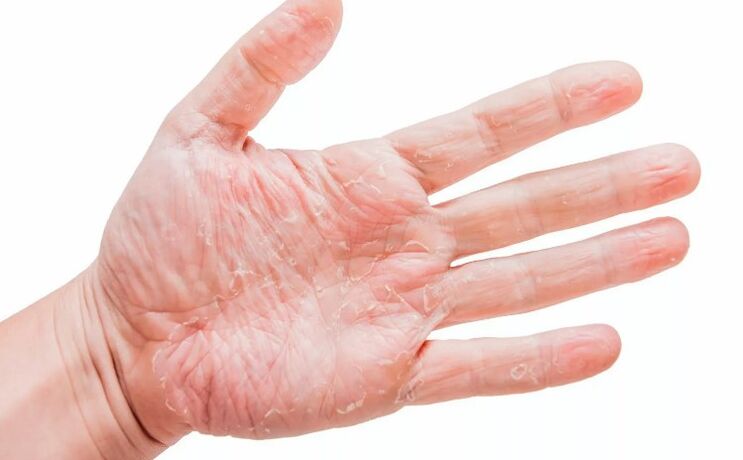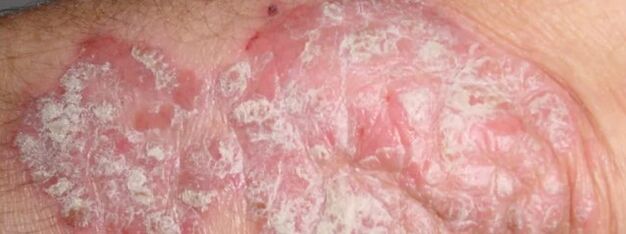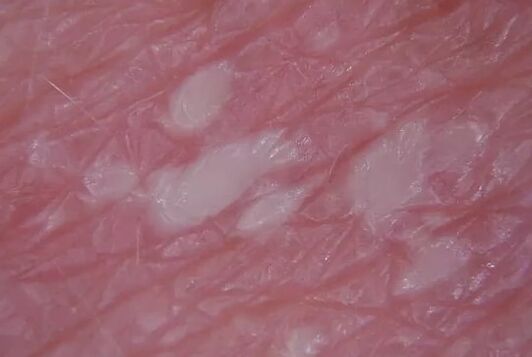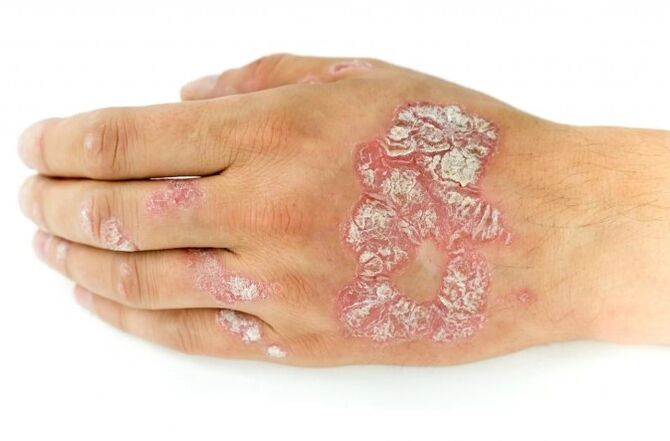Psoriasis is a chronic dermatological disease, the basis of pathogenesis, of which is abnormally fast skin cell growth, which leads to appearing on the surface of the skin compacted areas of various colors.
Today, Psoriasis has become the most common non-effective dermatological disease.Psoriasis has no gender predisposition - both men and women suffer from them as often.This pathology can be obtained at any age, but the first signs of the disease occur for up to 20 years.

Psoriasis is quite bad in therapy, partly due to the fact that so far etiology and pathogenesis of this pathology is still not clean.In addition, there is no means for specific psoriasis prevention, because it is impossible to determine whether a person has a predisposition to disease.
Reasons for development
Currently, scientists cannot answer the question unequivocally "Why is the psoriasis developing?".Two main disease development factors are different - this is the genetic predisposition and hyperreactivity of immunity systems.
Was founded until todayThe predisposition to the development of psoriasis is inherited.But difficulty is in the fact that it is extremely difficult to ask how exactly this predisposition is inherited and after the influence of whose factors can develop psoriasis.
The following factors are believed to cause psoriasis development:
- Frequent hypothermia skin, as well as the effect of dry air conditioning on it;
- Contagious processes;
- Frequent stresses;
- The use of some group of pharmaceutical products: nonsteroidal anti -infalmal medications (especially aspirin), some hypotonic and psychotropic drugs;
Pathogenesis
Currently, Psoriasis pathogenesis has not finally clarified.Two main links of pathogenesis can be distinguished:
- Violation of skin keratinization.
- Immunity disorder.
Together, the above factors of water the fact that the lower layer cells of the epidermis of the unknown reason start to share very quickly.This process leads to a reactive increase in the adoption of the upper layer of epidermal cells, which is manifested from the outside by peeling the skin.
Symptoms
The disease always begins acutely, without any lubincar development of the pathological process.As a rule, the first elements of the rash are localized in the place where the skin was damaged.
At the beginning of the symptoms of psoriasis on the skin, pink pinks or red appeared.This process is accompanied by itch.The size of the elements ranges from several millimeters to 1.5 centimeters (in some cases the elements reach even large in size).Then the elements of the rash are covered with easily separate silver scales.
Sometimes psoriasis damages nail plates.This pathology is externally reminiscent of fungal nail damage and is manifested by the following symptoms:
- There are many small indentations on the nail surface;
- The edge of the nail slab thickens and acquires boring, yellowish color;

Another characteristic manifestation of psoriasis is psoriatic arthritis (symmetrical damage damage and periarticular tissue).Most often, the pathological process is developing in the inter-inflammatory joints of the foot and hands.Initially, the disease is manifested by pain and swelling, and then the deformation of the affected joint develops, which can even lead to the patient's disability.It should be noted that in rare cases, damage is possible.Sometimes psoriatic arthritis develops even in the joints of the spinal column.
Types
The following types of psoriasis differ depending on the weight and characteristics of clinical events:
- Plakaper.This species is most often - diagnosed in almost 90% of people suffering from psoriasis.The elements of rashes theoretically can occur in any part of the skin.However, the most reported localizations are lower back, scalp and extensors of the upper and lower extremities (area of elbows and knees).It should be noted that with this form of psoriasis pathological elements do not appear on the face, palms and soles remain intact.Outside, this form looks like a pleat-plated pleat covered with silver with scales.When plaques are displayed under scales, Lymph is released.With further injuries, the plaque begins to bleed.The shape of psoriasis plates is also characterized by the appearance of such - the corrected "paraffin lakes" - the mouths of several plaques in one element.
- Reverse psoriasis (psoriasis of flexion surfaces or intertrigon).This form is pretty rare.Rash elements have a form of red spots without peeling, which do not protrude above the surface of intact skin.Typical Localization of this form of psoriasis - creases of leather (axillary cavities, inguinal overhang, leather under the chest in women).Also, due to the characteristics of localization, fungal infection often joins the reverse psoriasis.
- Genital psoriasis.This form is most often developed in girls, mainly in adolescence (up to 16).The pathological process is often developed preceded by streptococcal infection (for example, angina).Rasini with rocky psoriasis reminds of ordinary allergic rash - small dots that have a color from gray to quilt, not protruding above the surface of the skin.Such a rash can occur in any area of the skin.The skin on which rashes are found, as a rule has an inflamed look.
- Pustulenia psoriasis.It is a harder shape than the above.With pustular psoriasis, small painful crawls filled in Gus appear on the patient body.This pattern may appear both locally and in general.From pustular psoriasis, the general condition of patients often deteriorate, body temperature is growing.With a generalized form of pustular psoriasis, hospitalization is necessary.
- Erytroderma is the hardest form of psoriasis.With her almost the whole skin of the patient was damaged.This form accompanies the cold, increasing body temperature to high numbers, sharp deterioration in the patient state.This disease requires an emergency medical intervention, in absence in which a fatal outcome may occur.

Seriousness
There are many different buildings psoriasis in terms of seriousness.However, in routine clinical practice, the simplest of them is most often used, which does not require special research methods.
So distinguishThree degrees of psoriasis weightDepending on the prevalence of pathological proceedings:
- A slight form.This form is placed in cases where the patient influences psoriasis less than 3% skin.
- Moderate form.This diagnosis is made with damage to psoriasis from 3 to 10% of the patient's skin.
- A heavy shape.This form is exposed to taking into account the lesion of the skin and clinical manifestations.So, this form is exposed to a lying more than 10% skin or with a significant worsening of the patient's well-being.It should be noted that Psoriasis is considered serious in the presence of psoriasis arthritis, regardless of the degree of prevalence of the pathological process.
Stream of diseases and forecasts
Psoriasis is a disease with a wave-shaped course, ie there are periods of remission (when symptoms practically disappear) and deterioration.As a rule, the process worsens over the period out of the aliens.
The forecast for psoriasis depends on the form of disease and severity.As a rule, with classic forms of psoriasis, the forecast is favorable, but in difficult forms is possible, it is possible, and even death.
Despite a favorable forecast in most forms of psoriasis, do not forget about the social aspect of this disease.In an acute disease period, skin and hairy part of the human head are covered with peeling plates, which others often perceive as a manifestation of any infectious disease.Therefore, those around them start to distract the patient, which causes it to be closed, and often depression.
Diagnostics

The basis for diagnosis is the clinical manifestation of the disease, the characteristics of its current, as well as objective inspection data.There are several characteristic symptoms designated for the diagnosis of psoriasis:
- "Psoriathic Film" - If you clean the surface of the pipe papule, then it becomes smooth and great.
- "Stearin stains" - when the psoriatic elements are shown, their surface becomes whitish, the movies appear.
- "Blood of Rosa" - if after the event, the above symptoms do not stop the element belt, then their surface is covered with blood drops (capillary bleeding).
The above three described symptoms are called "psorijski triad" and are the main method of diagnosis of psoriasis.However, there are several other characters that are determined at a certain stage of the disease:
- In the acute phase of psoriasis are caused by pyling symptoms (psoriatic elements are surrounded by a red hoop) and kebner (new rashes are actively appear in damaged skin areas).
- The regression phases also determine the symptom of Voronov (around the elements of the glossy bread slice a little wrinkled leather).
The following is used in laboratory and instrumental methods:
- Microscopy of scales and pastry with potassium hydroxide (for differential diagnosis with fungal skin damage).
- In complex clinical cases, with an atypical course, the pathological elements resort to conduct a biopsy.
- With psoriac arthritis, the blood test indicators are examined (mainly the ESR and rheumatoid factor) and implemented X -Raja joints (for differential diagnosis with arthritis of other etiology).

Treatment
Treatment of psoriasis is a long and complex process.Unfortunately, since psoriasis is a chronic disease, the goal of therapy is not a patient's medicine, but achieving an extended remission and driving prevention.Treatment depends on the scene, shape and weight of psoriasis.It should be noted that the dermatologist must be prescribed by a number of medical measures and only after the fundamental testing of the patient and the diagnosis verification.
Diet.Treatment of psoriasis should begin with the correction of the patient's daily diet.If we are talking about general recommendations, then people with psoriasis should reduce the amount of protein in the diet and increase the amount of carbohydrates due to vegetable and fruit consumption.It is also necessary to exclude those products that can cause damage to psoriasis: alcohol, chocolate, various spices, as well as the limit of the use of garlic and port.It is also worth limiting the consumption of fried meat and fish, smoked meats.
Also, when collecting optimal nutrition, the patient's predisposition for allergies to any products and, if possible, turn off them should be taken into account.Optimal diet is the use of a large amount of fresh and vegetables and skinny varieties of meat and fish in boiled form.
Treatment of medicines.For psoriasis treatment, pharmacists are used in various forms of release: fats, pills, injections, etc.
In addition to local medications, the system is also used, when medications are prescribed in the form of tablets or injections.The following medications are most often prescribed:
- Immunosuppressants.Have an irresistible effect on the immunity system.It is prescribed only in heavy cases that are not subject to other therapy methods, because it has a large number of side effects and is difficult to convey.
- Cytostatics.Its action is focused on reducing cell division rate, leading to a reduction in psoriasis rates and peeling reduction.It is used only in very difficult cases, with resistance to other therapy methods.
- Various homeopathic drugs.Unfortunately, these medications are not suitable for all patients and there is no need for the necessary effect.

Photochemotherapy.Lighting is one of the main methods of psoriasis therapy.
In conclusion, it is worth noting that Psoriasis is complex and not fully studied disease.A qualified doctor must be done with treatment.Remember that no wonderful methods of praise on the internet will not be promoted to get rid of psoriasis.
The same can be said about folk medicine - all its methods will benefit only in combination with the basic medicines prescribed by a doctor who participates.
So, we can conclude that it will achieve success in treatment, the patient should use only those methods that agreed with his doctor who attended, as well as respect all his recommendations.This is the only way to achieve good success in treating and extended remission psoriasis.























